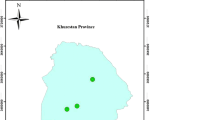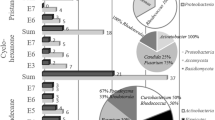Abstract
From undisturbed Antarctic habitats (permafrost sediments 30–150 thousand years of age, water of Radok Lake) and superficial deposits contaminated with petroleum products, we isolated 14 and 9 strains of Penicillium fungi, respectively. Comparison of the fungal complexes showed them to differ by species composition; only two species—P. palitans and P. solitum—were in the species lists of both groups. The identified secondary metabolites in the investigated strains belonged to diketopiperazine (group of roquefortines, rugulosuvin B), benzodiazepine (anacin, cyclopenins), quinoline alkaloids (viridicatins), clavine ergot alkaloids (α-cyclopiazonic acid, festuclavine, fumigaclavines), polycyclic indole alkaloids (communesin B, chaetoglobosin A), amino acid derivatives (N-acetyltryptamine, chrysogins, penicillin G), polyketides (citreoviridin A, mycophenolic acid), and terpenes (andrastins, phomenone). Strains isolated from anthropogenically altered habitats produced a more complete and characteristic profile of exometabolites, as compared with strains isolated from undisturbed habitats. It is only from contaminated soils there were isolated fungi that produced more structurally diverse secondary metabolites pertaining to polycyclic indole alkaloids and terpenoids. The fungi isolated from contaminated samples can be used in biodegradation of oil spills and bioremediation of the environment, and also as producers of promising biologically active compounds.
Similar content being viewed by others
References
Almamoori AM, Saleh MM, Salman JM (2017) Bioremediation of total petroleum hydrocarbons using cotton plant (Gossypium hirsutum) and applying augmentation technique by inoculation with Pseudomonas aeruginosa and Penicillium expansum. Int J Chem Tech Res 10:58–67
Ashrafi S, Helaly S, Schroers H-J, Stadler M, Richert-Poeggeler KR, Dababat AA, Maier W (2017) Ijuhya vitelline sp. nov., a novel source for chaetoglobosin a, is a destructive parasite of the cereal cyst nematode Heterodera filipjevi. PLoS One 12:e0180032. https://doi.org/10.1371/journal.pone.0180032
Chanda A, Gummadidala PM, Gomaa OM (2016) Mycoremediation with mycotoxin producers: a critical perspective. Appl Microbiol Biotechnol 100:17–29. https://doi.org/10.1007/s00253-015-7032-0
Chang Y-C, Yoshida E, Sato Y, Koyama D, Reddy MV, Iwasa T, Kikuchi S (2014) Selection and characterization of an alkylphenol-degrading fungus isolated from Antarctic soil. Proc 5th Forum on Studies of the Environmental and Public Health Issues in the Asian Mega-cities, Seoul, Korea
Chavez R, Fierro F, Garcia-Rico RO, Vaca I (2015) Filamentous fungi from extreme environments as a promising source of novel bioactive secondary metabolites. Front Microbiol 6:903–910. https://doi.org/10.3389/fmicb.2015.00903
Cole RJ, Schweikert MA (2003) Handbook of secondary fungal metabolites. Acad Press, Amsterdam, pp 1–3
Frisvad JC, Smedsgaard J, Larsen TO, Samson RA (2004) Mycotoxins, drugs and other extrolites produced by species in Penicillium subgenus Penicillium. Stud Mycol 49:201–241
Fukutomi Y, Taniguchi M (2015) Sensitization to fungal allergens: resolved and unresolved issues. Allergol Int 64:321–331. https://doi.org/10.1016/j.alit.2015.05.007
Hong SY, Roze LV, Linz JE (2013) Oxidative stress-related transcription factors in the regulation of secondary metabolism. Toxins (Basel) 5:683–702. https://doi.org/10.3390/toxins5040683
Huseyin CE, O’Toole PW, Cotter PD, Scanlan PD (2017) Forgotten fungi – the gut mycobiome in human health and disease. FEMS Microbiol Rev 41:479–511. https://doi.org/10.1093/femsre.fuw047
Kerzaon I, Pouchus YF, Monteau F, Le Bizec B, Nourrisson MR, Biard J-F, Grovel O (2009) Structural investigation and elucidation of new communesins from a marine-derived Penicillium expansum link by liquid chromatography/electrospray ionization mass spectrometry. Rapid Commun Mass Spectrom 23:3928–3938. https://doi.org/10.1002/rcm.4330
Kochkina GA, Ivanushkina NE, Karasev SG, Gavrish EY, Gurina LV, Evtushenko LI, Spirina EV, Vorob’eva EA, Gilichinskii DA, Ozerskaya SM (2001) Survival of micromycetes and actinobacteria under conditions of longterm natural cryopreservation. Microbiology (Moscow) 70:356–364. https://doi.org/10.1023/A:1010419831245
Kochkina G, Ivanushkina N, Ozerskaya S, Chigineva N, Vasilenko O, Firsov S, Spirina E, Gilichinsky D (2012) Ancient fungi in Antarctic permafrost environments. FEMS Microbiol Ecol 82:501–509. https://doi.org/10.1111/j.1574-6941.2012.01442.x
Konova IV, Sergeeva YE, Galanina LA, Kochkina GA, Ivanushkina NE, Ozerskaya SM (2009) Lipid synthesis by Geomyces pannorum under the impact of stress factors. Microbiology (Moscow) 78:42–47. https://doi.org/10.1134/S0026261709010068
Korneikova MV, Evdokimova GA, Lebedeva EV (2011) The complexes of microscopic fungi in cultivated soils polluted by oil products on the north of Kola peninsula. Mikol Fitopatol 45:249–256 (in Russian)
Levinskaite L (2018) Biodegradation potential of fungi Penicillium isolated from synthetic polymeric materials. J Environ Eng 144(7):06018002. https://doi.org/10.1061/(ASCE)EE.1943-7870.0001391
Li H, Xiao J, Gao YQ, Tang JJ, Zhang AL, Gao JM (2014) Chaetoglobosins from Chaetomium globosum, an endophytic fungus in Ginkgo biloba, and their phytotoxic and cytotoxic activities. J Agric Food Chem 62:3734–3741. https://doi.org/10.1021/jf500390h
Ozerskaya SM, Kochkina GA, Ivanushkina NE, Knyazeva EV, Gilichinskii DA (2008) The structure of micromycete complexes in permafrost and cryopegs of the Arctic. Microbiology (Moscow) 77:482–489. https://doi.org/10.1134/s0026261708040152
Pinedo-Rivilla C, Aleu J, Collado IG (2009) Pollutants biodegradation by fungi. Curr Org Chem 13:1194–1214. https://doi.org/10.2174/138527209788921774
Pitt JI (1979) The genus Penicillium and its teleomorphic states Eupenicillium and Talaromyces. Academic Press, London
Refai M, El-Yazid HA, Tawakkol W (2015) Monograph on the genus Penicillium. A guide for historical, classification and identification of penicilli, their industrial applications and detrimental effects. Cairo University, Faculty of Veterinary Medicine, Cairo
Rojas-Aedo JF, Gil-Durán C, Del-Cid A, Valdés N, Álamos P, Vaca I, García-Rico RO, Levicán G, Tello M, Chávez R (2017) The biosynthetic gene cluster for andrastin A in Penicillium roqueforti. Front Microbiol 8: Article 813. https://doi.org/10.3389/fmicb.2017.00813
Roze LV, Chanda A, Linz JE (2011) Compartmentalization and molecular traffic in secondary metabolism: a new understanding of established cellular processes. Fungal Genet Biol 48:35–48. https://doi.org/10.1016/j.fgb.2010.05.006
Samson RA, Frisvad JC (2004) Penicillium subgenus Penicillium: new taxonomic schemes, mycotoxins and other extrolites. Stud Mycol 49:1–143
Saraswathy A, Hallberg R (2002) Degradation of pyrene by indigenous fungi from a former gasworks site. FEMS Microbiol Lett 210:227–232. https://doi.org/10.1111/j.1574-6968.2002.tb11185.x
Semenov SM (1990) Laboratory media for actinomycetes and fungi. Manual. Agropromizdat, Moscow (in Russian)
Silva GH, de Oliveira CM, Teles HL, Pauletti PM, Castro-Gamboa I, Silva DHS, Bolzani VS, Young MCM, Costa-Neto C, Pfenning LH, Berlinck RGS, Araujo AR (2010) Sesquiterpenes from Xylaria sp., an endophytic fungus associated with Piper aduncum (Piperace). Phytochem Lett 3:164–167. https://doi.org/10.1016/j.phytol.2010.07.001
Sonjak S, Frisvad JC, Gunde-Cimerman N (2005) Comparison of secondary metabolite production by Penicillium crustosum strains isolated from Arctic and other various ecological niches. FEMS Microbiol Ecol 53:51–60. https://doi.org/10.1016/j.femsec.2004.10.014
Sonjak S, Frisvad JC, Gunde-Cimerman N (2006) Penicillium mycobiota in Arctic subglacial ice. Microb Ecol 50:207–216. https://doi.org/10.1007/s00248-006-9086-0
Spini G, Spina F, Poli A, Blieux AL, Regnier T, Gramellini C, Varese GC, Puglisi E (2018) Molecular and microbiological insights on the enrichment procedures for the isolation of petroleum degrading bacteria and fungi. Front Microbiol 9:2543. https://doi.org/10.3389/fmicb.2018.02543
Szatmari I, Lingvay M, Tudosie L, Cojocaru A, Lingvay I (2015) Monitoring results of polyethylene insulation degradability from soil buried power cables. Rev Chim 66:304–311
Thenmozhi R, Arumugam K, Nagasathya A, Thajuddin N, Paneerselvam A (2013) Studies on mycoremediation of used engine oil contaminated soil samples. Adv Appl Sci Res 4:110–118
Yang Y, Chen M, Li Z, Al-Hatmi AM, de Hoog S, Pan W, Ye Q, Bo X, Li Z, Wang S, Wang J, Chen H, Liao W (2016) Genome sequencing and comparative genomics analysis revealed pathogenic potential in Penicillium capsulatum as a novel fungal pathogen belonging to Eurotiales. Front Microbiol 7:1541. https://doi.org/10.3389/fmicb.2016.01541
Zain ME (2009) Effect of olive oil on secondary metabolite and fatty acid profiles of Penicillium expansum, Aspergillus flavus, A. parasiticus and A. ochraceus. Aust J Basic Appl Sci 3:4274–4280
Zehra A, Dubey MK, Meena M, Aamir M, Patel CB, Upadhyay RS (2018) Role of Penicillium species in bioremediation processes. Chapter 14. In: Gupta VK (ed) New and future developments in microbial biotechnology and bioengineering. Elsevier, Amsterdam, pp 247–260
Acknowledgements
The authors thank B.P. Baskunov (G.K. Skryabin Institute of Biochemistry and Physiology of Microorganisms, RAS, Pushchino, Russia) for mass-spectral data. This work was supported by the Russian Foundation for Basic Research, Projects No. 15-29-02629-ofi_m and No. 16-04-01050-a.
Author information
Authors and Affiliations
Corresponding author
Ethics declarations
Conflict of interest
The authors declare that they have no conflict of interest.
Additional information
Publisher’s note
Springer Nature remains neutral with regard to jurisdictional claims in published maps and institutional affiliations.
Electronic supplementary material
ESM 1
(DOCX 19698 kb)
Rights and permissions
About this article
Cite this article
Kozlovsky, A.G., Kochkina, G.A., Zhelifonova, V.P. et al. Secondary metabolites of the genus Penicillium from undisturbed and anthropogenically altered Antarctic habitats. Folia Microbiol 65, 95–102 (2020). https://doi.org/10.1007/s12223-019-00708-0
Received:
Accepted:
Published:
Issue Date:
DOI: https://doi.org/10.1007/s12223-019-00708-0




